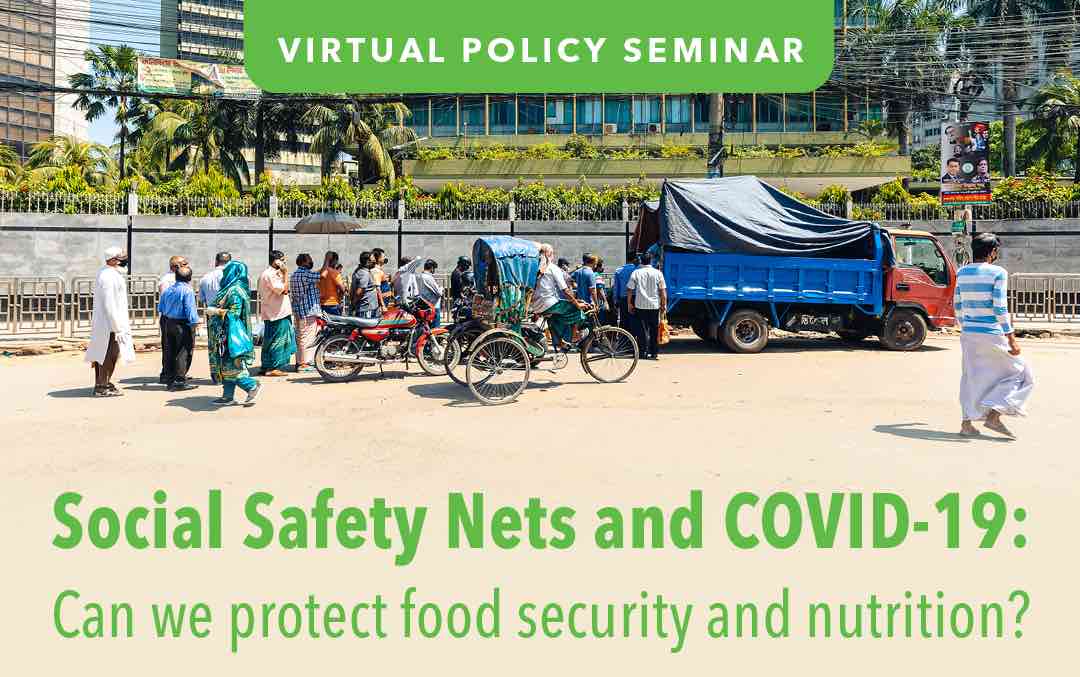Policy seminar: Social safety nets as a COVID-19 response to protect food security and nutrition
- From
-
Published on
07.07.20
- Impact Area

By Khiem Nguyen
As countries grapple with the health and economic shocks caused by COVID-19, an IFPRI estimate indicates that 140 million people globally are at risk of falling into extreme poverty. Many governments have expanded social safety net systems in order to mitigate the risks. A June 11 virtual event—co-organized with the CGIAR Research Program on Policies, Institutions, and Markets (PIM)—focused on social safety nets in COVID-19 response and their role in sustaining food security and nutrition.
“Past IFPRI research shows that social safety nets can help limit further harm among vulnerable populations by bolstering food security and assets, and with the potential to protect child nutrition with effective program designs,” said Daniel Gilligan, Deputy Director of IFPRI’s Poverty, Health, and Nutrition Division. However, the unprecedented nature of the pandemic also poses new challenges—such as how to safely deliver food and cash transfers without increasing exposure to the novel coronavirus and how to target newly vulnerable households.
“I think there is little doubt that we are in the middle of one of the largest social protection scale-up efforts in modern history,” said Ugo Gentilini, Senior Economist of the Social Protection and Jobs Global Practice at the World Bank. The number of countries that have planned or introduced social protection measures in response to COVID-19 quadrupled from 45 countries to 190 countries worldwide between late March and early June, and 988 social protection measures benefiting 1.7 billion people had been implemented, a tenfold increase.
Yet only 15% of those measures are related to food consumption, nutrition, and food security. In many impoverished regions, social protection coverage remains low and grants remain inadequate to fully support beneficiaries. For example, in Africa, the coverage of cash transfers is only at 2%, and spending per capita is equivalent to the Middle East while undernourishment levels are twice as high.
Following Gentilini’s global overview, presenters focused on Bangladesh and Ethiopia, two countries with extensive social safety net systems that IFPRI and its partners have studied for years.
Related news
-

Reinventing Kenya’s Snack Future with Dryland Grains
International Crops Research Institute for the Semi-Arid Tropics (ICRISAT)21.11.25-
Nutrition
-
Poverty reduction, livelihoods & jobs
Faces of Impact - Video Feature Story On a quiet backstreet in Mihango, Kenya, the…
Read more -
-

COP30 can enable Greening Plant Nutrition in East and Southern Africa
International Rice Research Institute (IRRI)17.11.25-
Nutrition
Image creditAfrica rice farming by majimazuri21, Pixabay Licence By Jamie Males (republished from …
Read more -
-

Positioning healthier rice varieties in Odisha for market demand and farmer income
International Rice Research Institute (IRRI)28.10.25-
Nutrition
-
Poverty reduction, livelihoods & jobs
In western Odisha, farmer groups and women’s self-help groups are taking the lead in bringing…
Read more -
